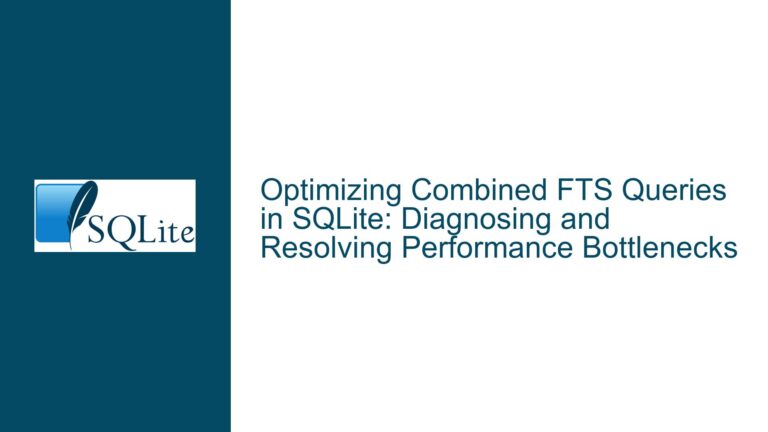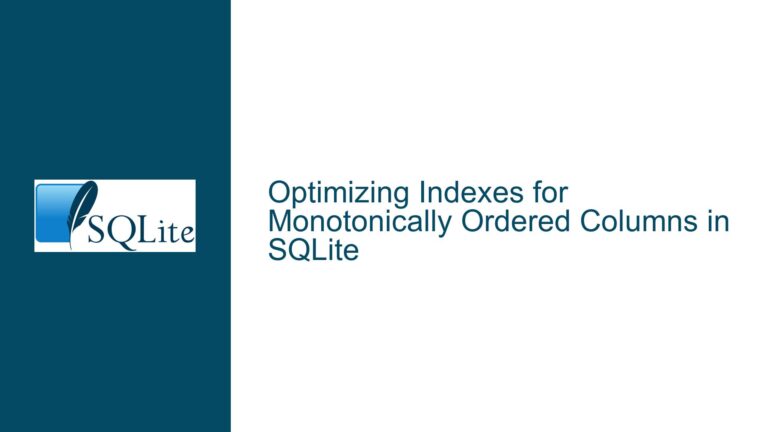Optimizing Cross-Platform SQLite Performance in Java for Android and Desktop
Transaction Speed Discrepancy Between Android and Desktop SQLite Operations
Issue Overview: Performance Variance in Bulk Insert Operations Across Platforms
The core challenge involves a Java-based application designed to operate portably across Android and desktop environments, utilizing SQLite for data storage. The user observes significant performance differences when inserting 10,000 rows with two indices (a unique index on column 2 and a composite non-unique index on columns 1+2). The desktop (Intel Core i3 8th Gen) completes the operation in 150 ms with a single transaction, while the Samsung A42 phone requires 1,000 ms. This discrepancy raises questions about SQLite’s ability to leverage multi-core architectures, storage I/O efficiency, and platform-specific optimizations.
The problem intersects three domains:
- SQLite’s Transactional Behavior: SQLite serializes write operations by design, prioritizing ACID compliance over parallelism. Even when using a single transaction, the time required to commit data to storage depends heavily on the underlying hardware’s I/O capabilities.
- Platform-Specific Storage Subsystems: Desktops typically employ SSDs or HDDs with large RAM caches, whereas mobile devices rely on NAND flash storage with slower write speeds and aggressive power management.
- Java Wrapper Implementation: Abstracting SQLite across Android (via
android.database.sqlite) and desktop Java (e.g., JDBC, Xerial SQLite-JDBC) introduces potential overhead in transaction handling, connection pooling, and resource management.
The performance gap is not inherently due to SQLite’s query execution but stems from differences in how each platform handles storage I/O, memory allocation, and threading. For instance, Android’s SQLite implementation includes platform-specific optimizations like SQLiteStatement reuse and connection pooling, while desktop Java libraries may lack equivalent optimizations. Additionally, mobile flash storage controllers prioritize power efficiency over raw throughput, introducing latency during bulk writes.
Underlying Factors: I/O Bottlenecks, Transaction Design, and Configuration Mismatches
Storage Hardware and I/O Prioritization
Mobile devices use embedded MultiMediaCard (eMMC) or Universal Flash Storage (UFS) with slower sequential write speeds (e.g., 250 MB/s for UFS 3.1 vs. 3,500 MB/s for NVMe SSDs). However, the disparity in observed times (1,000 ms vs. 150 ms) suggests deeper issues:
- Write Amplification: Flash storage requires erasing blocks before rewriting, increasing latency.
- Filesystem Journaling: Android’s ext4 or F2FS filesystems journal metadata changes, adding overhead absent in desktop filesystems like NTFS or APFS.
- SQLite’s Synchronous Settings: The
PRAGMA synchronousdirective (defaultFULLon Android, oftenNORMALon desktop) forces the OS to flush writes to storage immediately, impacting performance on slower media.
Transaction Scope and Indexing Overhead
Creating two indices during a bulk insert operation introduces CPU and I/O contention:
- Unique Index Validation: SQLite checks uniqueness constraints for each inserted row, requiring read-modify-write cycles.
- Composite Index Page Splits: The non-unique index on columns 1+2 may fragment B-tree pages, increasing disk seeks.
- Transaction Atomicity: A single transaction guarantees atomicity but delays index updates until commit, creating a large write burst.
Java-to-SQLite Integration Inefficiencies
- JNI Overhead: Android’s SQLite API uses JNI (Java Native Interface), which introduces context-switching penalties. Desktop Java drivers like SQLite-JDBC may bypass JNI but suffer from garbage collection pauses.
- Prepared Statement Caching: Failing to reuse
SQLiteStatementobjects on Android forces recompilation of SQL queries. - Connection Pooling: Desktop environments may not reuse database connections efficiently, increasing file locking contention.
Concurrency Misconfigurations
SQLite’s threading mode (PRAGMA threads) and memory-mapped I/O (PRAGMA mmap_size) settings differ across platforms. Android enables memory-mapped I/O by default, while desktop configurations may not.
Resolving Performance Gaps: Platform-Specific Tuning and Code Refactoring
Step 1: Isolate I/O and CPU Contributions
- In-Memory Database Test:
Create an in-memory SQLite database (:memory:) on both platforms to eliminate storage I/O variance. If performance gaps disappear, focus on storage optimizations. - Microbenchmark Index Operations:
Time index creation separately from data insertion. UsePRAGMA schema_versionto force index rebuilds and measure their standalone cost.
Step 2: Optimize SQLite Configuration Pragmas
- Desktop and Android Synchronous Settings:
SetPRAGMA synchronous = OFFduring bulk inserts to disable synchronous writes. Warning: This risks database corruption on power loss. - Increase Memory-Mapped I/O:
PRAGMA mmap_size = 268435456(256MB) allows SQLite to bypass filesystem I/O by mapping database pages directly into memory. - Adjust Journal Mode:
UsePRAGMA journal_mode = WAL(Write-Ahead Logging) to enable concurrent reads/writes and reduce fsync() calls. Note that WAL requires-shmand-walfiles, which may not be portable across all Android filesystems.
Step 3: Refactor Transaction and Index Strategies
- Batch Inserts into Smaller Transactions:
Commit every 500-1,000 rows to distribute I/O load. This reduces peak memory usage and allows the OS to interleave writes with other operations. - Defer Index Creation:
Create indices after inserting data usingCREATE INDEX post_insert_idx ON table(col1, col2). This avoids incremental index updates during insertion. - Use TEMP Tables for Intermediate Data:
Insert data into a temporary table without indices, thenINSERT INTO main.table SELECT * FROM temp.tableto minimize write amplification.
Step 4: Tune Java Database Connectivity
- Android-Specific Optimizations:
- Reuse
SQLiteStatementobjects withbindString(),bindDouble(), etc., to avoid recompiling SQL. - Enable connection pooling with
enableWriteAheadLogging().
- Reuse
- Desktop Java Optimizations:
- Use SQLite-JDBC with
busy_timeoutsettings to handle locking contention. - Disable auto-commit mode via
Connection.setAutoCommit(false)and manually commit transactions.
- Use SQLite-JDBC with
Step 5: Leverage Platform-Specific Storage APIs
- Android Direct I/O Bypass:
UseSQLiteDatabase.disableWriteAheadLogging()to revert to rollback journal mode if WAL causes issues on older devices. - Desktop Filesystem Tuning:
Ensure the database file resides on a non-network drive with disabled antivirus scans during bulk operations.
Step 6: Analyze Threading and Memory Allocation
- SQLite Threading Modes:
ConfigurePRAGMA threads = 4to allow parallel sorting operations. Note that SQLite’s core engine remains single-threaded for writes. - JVM Garbage Collection Tuning:
Increase the Java heap size (-Xmx4G) on desktop to reduce garbage collection pauses during large transactions.
Step 7: Profile and Compare Platform Traces
- Android Profiling:
Use Android Studio Profiler to trace disk I/O, JNI calls, and lock contention during inserts. - Desktop Profiling:
Employ VisualVM or JProfiler to monitor JDBC driver performance and native memory usage.
Step 8: Evaluate Alternative SQLite Engines
- Android-Ready Forks:
Integrate Requery SQLite Android for enhanced concurrency support. - Desktop Native Libraries:
Use sqlite3_prepare_v3 withSQLITE_PREPARE_PERSISTENTto cache prepared statements across connections.
Final Step: Cross-Platform Regression Testing
Implement continuous integration (CI) pipelines that benchmark SQLite operations on both Android emulators and desktop hardware. Use Android Emulator snapshots to reset storage states between tests, ensuring consistent I/O performance measurements.
By systematically addressing storage I/O limitations, reconfiguring SQLite pragmas, and refining Java integration code, developers can narrow the performance gap between mobile and desktop environments. The key lies in recognizing that SQLite’s portability does not imply uniform performance characteristics—each platform demands tailored optimizations.






